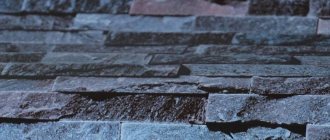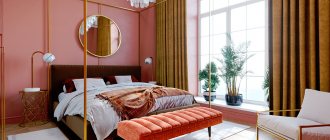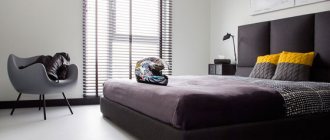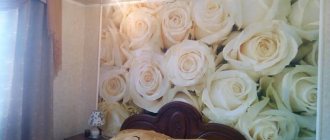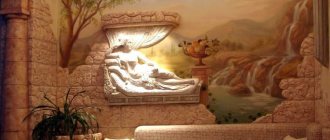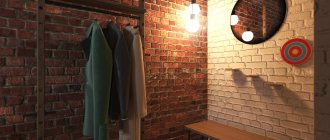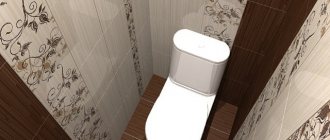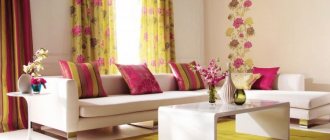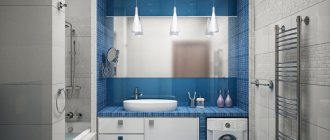What are 3D gypsum panels?
Gypsum 3D panels for walls, as in the photo, are square, rectangular or block tiles of other shapes. On the front side there is some kind of ornament or imitation of natural material applied to it. The back side is usually flat. There are panels in which both sides follow the contours of each other. This is done specifically to reduce the weight of the slab and facilitate self-installation. On average, its dimensions are 50x50 cm and its weight is about 4.5 kg.
The production technology of all manufacturers is almost the same. First, a solution based on G-16 gypsum is mixed. Then it is poured into plastic molds with the necessary ornaments. When pouring the mixture, the matrix vibrates slightly, thereby ensuring uniform distribution of the composition. After drying, the slabs can be used.
Brick finishing options
You can make a brick wall indoors a reality by using ready-made factory-produced tiles, or you can recreate everything with your own hands from scrap materials.
- As a factory product, artificial brick-like stone is produced from the following components:
- Decorative bricks made of resin and a special polymer base. In this case, it becomes possible to produce white, burnt, red, beige or combined bricks. In appearance, the products are indistinguishable from natural bricks. This material is characterized by its light weight, ease of cladding, resistance to temperature changes and moisture, which allows it to be used for cladding Russian stoves and fireplaces, and work surfaces in kitchens. It is also characterized by a long service life and ease of maintenance;
- Bricks made of burnt slate clay, indistinguishable from the original. They have good wear-resistant properties, but their weight is more significant;
- Gypsum tiles are made on the basis of gypsum, are easy to install, painted in the desired shade, but they are quite fragile, but they are available in a price range and are often used for room decoration;
- Fiber cement brick panels have a very long service life, as they are made on the basis of cement and stone, have an aesthetic appearance and meet all the requirements for environmental friendliness, are very durable, but are most often used to imitate a brick wall on the facade of a building, since they have significant weight.
Imitation of a brick wall using gypsum tiles
- To create an exclusive interior, you can complete the entire process yourself, recreating a decorative brick wall in your apartment using the following materials:
The simplest option is to use paintable wallpaper with a brick textured finish. Using construction tape, squares on the wallpaper are pasted over, everything is covered with an even layer of acrylic paint, after it dries, the tape is carefully removed. It turns out quickly, cheaply, but not entirely durable and realistic;
Brick wallpaper
Decorative plaster - no special preparatory work is required to cover the walls evenly, the process is quite quick, but at the same time, masonry can only be recreated on the wall, and it is not always able to replace real brickwork;
Decorative plaster with imitation brick
Decorative bricks made of foam plastic and plasterboard sheet. A convenient option when working with frame structures and curved walls, it is quite labor-intensive, but the appearance is very realistic. The big disadvantage is the increased flammability and toxicity of polystyrene foam. A fairly inexpensive option for recreating decorative brick;
Functionality of 3D gypsum panels
Using gypsum 3D panels in the interior, you can quickly change the design of the room, make it stylish and modern. With their help:
Rooms are zoned.
They set up partitions, hide pipes, wiring, and wall defects.
Finish ceilings, walls, headboards, kitchen aprons.
They decorate furniture, supporting columns, and design niches.
Types of decorative wall panels by material
In fact, it is not enough to cover a wall with any panels you like. Only those types of finishes that are correctly selected in size, texture and material can achieve the desired result, complement, and decorate the interior. Before going to such design delights, it is worth familiarizing yourself with the features of existing options, their advantages, as well as disadvantages.
Three-dimensional gypsum and aluminum boards
Gypsum 3D panels for walls, today, are the most popular material for this method of interior decoration. The advantages include good sound insulation, environmental friendliness and ease of assembly. In addition, gypsum as a material has good durability.
In terms of decoration, gypsum material can be repainted several times a year. Any minor damage can be easily leveled with a spatula or ordinary sandpaper.
Aluminum three-dimensional plates, due to their low weight, are easy to install. And their metallic properties mean you don’t have to worry about indoor humidity.
3d panels made of wood and bamboo
Everyone probably knows the basic mechanical properties of wood. These include hardness, wear resistance, strength and elasticity. Let's add to this that wood improves sound insulation and retains heat. Therefore, 3D wood panels for walls deserve special attention. Depending on the chosen breed, it is necessary to estimate the weight of the future structure in advance.
The bamboo option is suitable for rooms with low humidity. This wood material does not tolerate any dampness well, and its service life will be minimal. But bamboo panels are easy to install, easily sitting on the walls using ordinary glue.
From chipboard and fibreboard
Chipboard panels (chipboards) are very rare. They have a relatively low cost, a low level of moisture resistance and an unassuming appearance. Can be installed in dry, warm rooms.
Chipboard has a characteristic structure
Fiberboards are made by grinding wood and then pressing it under high pressure. Modern products use eucalyptus tree resins as a binder instead of formaldehyde. Thanks to this, they can be used for finishing walls in residential premises. Lamination and the introduction of water repellents into the material make it possible to use them for decorating rooms with high levels of humidity.
The formation of fiberboard panels is carried out by pressing prepared raw materials
Cork
This material is simple and will be enthusiastically welcomed by housewives, since it does not attract dust at all. In addition, natural and environmentally friendly panels prevent mold from growing. Durability and high strength can be added to the advantages. As well as increasing the insulating properties of the wall.
3D wall panels made of MDF
Advantages of embossed MDF panels:
- the ability to create complex, three-dimensional ornaments;
- strength;
- resistance to temperature changes and high humidity;
- 3D facades for furniture are made on the basis of MDF.
Disadvantages ▫ MDF is a highly flammable, moderately flammable material with high smoke-generating ability and toxicity when burning.
3d panels made of plastic and glass
All the benefits of plastic have long been known. This material is easy to manufacture, durable and has an inexpensive production cost. Polyvinyl chloride is used as a material for the production of three-dimensional panels, being a colorless and transparent material.
The shape of this plastic ideally imitates brick or wooden structures. The relief of plastic blanks is varied. Their depth ranges from 30 to 120 mm. For example, the article presents photos of 3D panels for walls.
3D glass panels have only recently conquered the market. The glass structures themselves look very impressive, especially with certain lighting.
But glass is a fragile material and requires special attention, both during installation and during operation. 3D glass panels have a significant weight, and their purchase will cost a significant amount.
3D polyurethane panels
Advantages:
- are light in weight;
- immune to temperature changes and high humidity;
- durable, under conditions of careful use.
Disadvantages ▫ polyurethane is considered an environmentally friendly material, but when burned it releases a large amount of toxic substances.
Flexible decorative concrete panels ArtLoft
The advantage of flexible Art Loft panels is their ability to take the shape of a curved surface, lightness and moisture resistance. Decorative concrete wall panels are designed for interiors in Loft style, modern interiors, Hi-Tech and are a stylish solution for decorating a modern office.
Decorative concrete panels are made from natural, environmentally friendly, but at the same time durable and reliable materials. Foamed PVC does not emit anything into the air, even compared to furniture panel materials.
Thanks to manual stamping technology, Art Loft concrete wall panels look as close as possible to natural cement. Each panel has its own unique pattern, which gives many unique combinations for your design solutions.
Concrete-look wall panels for interior decoration are easy to cut and install on walls or ceilings using glue or liquid nails. Panels measuring 600x600 are easy to install in a suspended ceiling. The joints between the panels do not require grouting.
They are easy to care for as they can be easily wet and dry cleaned. Also, the panels bend easily and are attached to curved surfaces.
To order panels, you must indicate by phone or email the article number of the selected panel and the required quantity in pieces. In the response letter we will issue an invoice, and after the funds are received on the account, we transfer the order to production. The execution time depends on the order volume (on average - 5 working days).
There may be slight differences in color within +- 5% in different batches of panels. So try to correctly calculate the order volume right away.
Types of panels by size and shape
The emergence of panels for wall decoration must be thanked to medieval France. It was there that carved boiserie made of wood with gilding appeared. They decorated palaces, and from that time on, the use of such decorations became a sign of wealth and aristocracy.
Today, decorative panels are a rational solution to many problems during renovation. Due to the fact that the material is attached to the sheathing, you can hide any unevenness in the walls. And they refuse plaster altogether.
Leafy
The finishing material is significant in size. The panel height starts from 2.2 meters and reaches three. Width – 1.25 m. The main advantage of the material is that in case of slight curvature of the walls, it is attached directly, without a frame. Another significant advantage is that panels are always selected that will cover the wall completely, without additional additions.
Gypsum sheet decorative panels for interior cladding, with wood imitationSource decoroom.su
The panels are made from the same raw materials as the previous type. But in this case, PVC products have some advantages, since the necessary relief is formed on the plastic, which helps to copy natural materials. Often they convey an image of a tiled wall. But all types of masonry are also popular. From brick to stone.
Some new products have found application in PVC panels. For example, materials with photo printing are in demand for kitchen areas. The print can be very diverse, up to a relief image in 3D. As a rule, the design serves as a kitchen apron - instead of tiling the walls.
Rack and pinion
Considerable in length, but small in width. The connection between each other occurs with a tenon in a groove. Therefore, there is a protrusion on one side of the panel, and a receiver on the other. Most often they are placed vertically on the wall, and therefore the sheathing is mounted horizontally.
Decor is made from fiberboard, chipboard, MDF and plastic. The latter acts as the most inexpensive option, but it is successfully used to decorate bathrooms and kitchens, since there are waterproof models. Otherwise unreliable due to fragility.
Vertical plastic panels with wood imitation, masking the interior doorSource union.ru
Although the length of the slatted panel starts from 2.4 meters, this size is not always enough to completely cover the wall. Therefore, special additional elements are additionally produced, which are needed to complete the corners or edges of the trim.
Fastening to the sheathing occurs using self-tapping screws or paper clips for a construction stapler. But there is also a more convenient special fastener. The hidden connection is made with clamps. They are attached to the sheathing, and the strip is held in place with a tongue.
Location of 3d panels
Depending on the area of the room, horizontal or vertical panels can be used. For a low ceiling, vertically oriented slabs are used, and for a high wall, vice versa.
Also, when choosing, you should take into account the visual effect of glass, plastic or wooden 3D panels for walls. A large pattern makes the room smaller, while a small one makes it larger.
Lighting
The panels are illuminated using a large number of LEDs. Depending on the room, different levels of lighting are required. It looks especially beautiful when installing glass volumetric slabs.
The most popular material for lighting volumetric tiles is LED strips. They are placed around the perimeter and then soldered.
Gypsum metal sheets and profiles for them
Gypsum metal panels have the greatest strength. The plasterboard sheet is firmly glued to the metal sheet on one or both sides. The following is used as a decorative layer:
- aluminum;
- stainless steel;
- galvanized sheet.
The steel may not be coated. The remaining materials are covered with a multilayer protective film of polymers.
The high cost and limited color palette make gypsum metal sheets not popular in private houses and apartments. They are used for finishing walls of “clean production” plants. Mainly in the food and pharmaceutical industries and in the production of microcircuits.
Gypsum metal sheets guarantee sterile cleanliness and are not afraid of solutions of acids and alkalis.
They sell GML together with a special profile from which the frame is assembled, frames are made around the openings, and the joints are covered. Separately, add-ons are installed on internal and convex corners and baseboards.
Gypsum metal sheets are mounted by fixing the side metal projections to the posts. Locks are used less frequently. A special elastic profile matching the color of the panels is inserted into the gap. Thanks to him, the joints become invisible.
Depending on desire and capabilities, everyone can choose gypsum panels to their taste or make them themselves. After installing them, the room will be cozy and comfortable.
Installation methods
The procedure for performing installation work may vary significantly. 3D panels are glued to the base or screwed to the sheathing. We invite you to get acquainted with the distinctive features of each option.
On the frame
The panels are installed on a metal or wooden frame. Its presence reduces the internal space of the premises, but allows you to avoid leveling the base. After installing the frame, the 3D panels are attached to the structure using screws. Holes are drilled in the elements themselves and then sealed with putty. It is possible to use special fasteners.
The sheathing should be securely fixed
On glue
With the adhesive method of fastening, the base is first carefully leveled and cleaned. The leveled surface is primed. Installation work is carried out in the following sequence:
- Markings are applied. The position of each line is controlled using a level;
- Glue is applied. Its composition is selected taking into account the material of the 3D panels. To evenly distribute the glue over the base, a notched trowel is used;
- The first panel is applied to the wall according to the markings made, takes root and is held in place for the time recommended by the manufacturer of the adhesive composition;
- Subsequent elements are attached to the wall in the same way. In this case, a gap must be maintained. If a seamless option is chosen, putty is applied to the end of the first panel to form a tight connection. The glued element is pressed against the wall and the end of the adjacent fragments.
Installation is carried out on a leveled base
Paint and varnish
After the panels are laid, the seams are sealed and the wall is coated with primer, the work needs to be painted. Water-soluble acrylic paint is suitable for this. The colors must match the concept. That is, if these are bubbles, then they can be blue or rainbow, and the texture imitating wood can be of various brown shades.
The paint is applied mainly with a roller, and where it is difficult to get a roller - with a brush. But if you want to achieve professional quality with an even finish, then a spray gun is your best option.
To finally protect the coating, a water-soluble varnish can be applied to the panels after the paint has completely dried. The varnish can be matte or glossy.
The varnish will complement the design and protect the panel from settling dust, moisture and ultraviolet rays.
3D panels for walls in the interior of different rooms: application options with photos of ready-made solutions
To choose the right design for a specific room, check out the ready-made solutions. We invite you to look at photos of completed projects so that you can choose the right option for yourself.
Living room and hallway
3D panels are most often used to decorate walls in living rooms. With their help, a TV zone is created. The pattern can be anything, but models that imitate waves or have modern geometric shapes look original. When decorating a fireplace area, you should choose a pattern that will match the design of the hearth in style and texture. For an interior in a classic style, you can choose elements that imitate capitonium fabric or carriage screed. Light shades are preferred.
For a hallway, 3D panels are purchased only if it has a sufficiently large area. With their help, you can add originality to the room and emphasize its originality. If the corridor is narrow, installation on the sheathing should be abandoned.
Bedroom decor
There are usually not many places in the bedroom where a voluminous texture will look advantageous. In most cases, this is the wall at the head of the bed. It is important that the selected texture and color of the material successfully complement the overall design.
If the decor has a small pattern, sometimes the entire sleeping area is highlighted: the decoration along the width of the bed is raised to the entire wall and placed three-quarters on the ceiling. In small rooms, a small decorative panel on the wall will look better. Less often, the wall opposite the bed is made voluminous, as a rule, if a TV is placed there.
For children's room
Some manufacturers offer a special range for children's rooms. Such panels often take the form of Lego cubes, various geometric shapes, and colors.
An interesting addition for a nursery would be a part of the wall with a wave-like texture, which is painted in rainbow colors. In children's rooms, this decor is recommended to be used only in the play area.
Bathroom cladding with 3D panels
In bathrooms, volumetric panels are used locally or to highlight a separate area in combined bathrooms. You can select any zone if you choose a material that is not affected by moisture and temperature.
Most often, the wall above the bathroom or a completely free wall is made voluminous. An unusual finish will help highlight the toilet area and will not put a strong emphasis on it if it is in lighter shades.
3D panels are such a diverse and versatile material that they can be used anywhere. In addition to the rooms described above, you can decorate the loggia, do wall decoration near the stairs, in the hall or hallway.
Use in the kitchen
The second most popular option is to use 3D panels for walls in the interior of a kitchen or dining room. Here, as a rule, preference is given to plastic or MDF panels, since they are easy to care for and resistant to moisture. If we are talking about the use of gypsum materials, then they are additionally coated with water-repellent varnishes.
Most often, the material is used to line the working wall. You can also successfully highlight a dining area in the kitchen. In spacious rooms, this type of finishing can be used in two places at the same time, creating a more holistic design.
In the corridors
Small narrow rooms are not well suited for installing gypsum panels, but lately designers have been trying to decorate small spaces with materials whose texture skillfully imitates carriage ties or capitonné. Light-colored products fit well into classic interiors, while dark-colored ones are ideal for lovers of a mystical mood.
Typical Application
Considering the performance characteristics of gypsum panels for interior wall decoration, there are no restrictions on the use of the material:
- Living spaces. Living room, bedroom, children's room, office, kitchen, bathroom, toilet, dining room, hallway.
- Commercial properties. Offices, shopping galleries, reception areas, banks, catering.
- Public buildings. Educational and medical institutions, airports and train stations, exhibition complexes.
It is profitable to buy 3D gypsum panels for walls in our online store. Experienced consultants will help you choose a collection, calculate the required volume, tell you how to get huge discounts and offer the best method of delivery and payment. Contact us, we are very glad to see you!
Advice from experienced designers
When choosing 3D panels for walls in the interior of a particular room, pay attention to the designers’ recommendations. In them you can find a lot of things that will be useful when arranging an interesting interior design.
- The use of materials with three-dimensional relief images is more suitable for spacious rooms. Small fragments, on the contrary, look better in small ones.
- It is not necessary to emphasize textured walls with a pronounced shade. The relief of 3D panels itself will accentuate attention, even if it is not highlighted with color or lighting.
- The choice of pattern affects the visual perception of the room. Thus, horizontal stripes make the room wider and elongated. Vertical - on the contrary, visually distances the ceiling. Thus, it is preferable to select a pattern in accordance with this condition and a predetermined goal: raising the ceiling or expanding the walls.
- The use of 3D panels in bright, saturated colors requires a light, laconic shade of the remaining walls.
- The relief of 3D panels will be noticeable in any case. Its hue will change depending on the viewing angle. You can further enhance the visual effect of the surface by illuminating it with any type of lamp (wall, floor, ceiling or strip).
- A variant of the local relief is reproduced in the form of a separate art object, where three-dimensional panels are used. It is possible to reproduce a finished pattern or create your own, original one. This is done through a combination of individual patterns.
- The deep textured pattern looks great in the living room, study, or office. Softness, tenderness and conciseness are more acceptable in the bedroom or bathroom.
- In addition to color, pattern and relief, 3D panels can be glossy or matte. The matte surface brings warmth, comfort, tranquility to the room, and helps to lift your spirits. Gloss – increases the amount of optical distortion and makes the room more spacious.
Important! 3D panels in the interior act not only as a finishing material, but also as a decorative one. Therefore, the surface should not be blocked by furniture or supplemented with accessories.
How to decorate a wall with 3D gypsum panels yourself
As already mentioned, one of the positive qualities of gypsum panels is ease of installation. And it’s quite possible to handle the installation of 3D panels yourself. Plus it can be a fun activity.
The main point is surface preparation:
- remove all crumbling areas of plaster and putty;
- then you need to seal all the holes that appear. Cracks should be widened and strengthened;
- When the putty dries, the surface should be primed.
- If the wall has large differences or unevenness, it must be leveled using plaster or drywall.
If you purchase gypsum 3D panels from us, the kit includes adhesive for installation.
Which panels to choose
On the construction market there is 3D cladding with the following patterns:
- Lines are smooth lines with soft transitions. The stripes vary in width. Direction horizontal, vertical or diagonal. Sometimes it resembles a footprint in the sand from a passing wave. The height of the plane above the plane is also different. This finishing material is used for recreation. Let's say in the bedroom.
- Honeycombs have cells of varying depths and sizes. The panel can be produced with slightly applied honeycombs or with a very voluminous pattern. The walls in the hallway and hallway are decorated with this type of decoration.
- Stone - brickwork. The bricks have both smooth and rough surfaces, which closely resembles real brickwork. The arrangement of bricks is staggered or horizontal with seams. Sometimes panels are created in the form of cracked plaster. This material is used for wall cladding in the living room and hallway.
- The fabric is upholstery with buttons on the sofa. Can also be in the form of wood. This cladding is suitable for an office or library.
- The abstraction is made in loft, hi-tech, minimalism style. They use different patterns for this. Rectangles, passages. They protrude above the surface and intersect each other. This finish looks decent in any room.
- Bubbles are a repetition of the shapes of soap bubbles on the wall, protruding above the surface at different heights. The bubbles are also small and large. If properly processed, they will look good on the side wall on the balcony.
- Flowers and plants - such a panel is used in various rooms, but in a small area, because it will look cluttered.
The choice of cladding is large. Therefore, it must be treated responsibly. This will emphasize the individuality of the interior and decorate the room.
What you need
After measuring the surface for cladding, the following materials and tools are required:
- the required amount of facing material;
- primer on walls against fungus with antiseptic;
- glue;
- level, meter, pencil;
- sandpaper, hacksaw for cutting panels;
- rubber spatula, paint, brush, roller.
If they are making sheathing, the set of tools is somewhat different: a screwdriver, dowel-nails, wooden slats or metal profiles, self-tapping screws.
Progress
- After cleaning and priming the surface, you need to make markings. The panels are primed from the back and left to dry. Afterwards, the entire drawing, like a puzzle, is laid out on the floor.
- After this, stir the adhesive composition. Gypsum adhesives dry quickly, so the solution must be prepared in small volumes.
- Craftsmen begin work from the bottom corner of the surface. By installing a guide profile or wooden strip to hold the material on it.
- The glue is applied to the tile with a spatula and applied according to the markings on the surface.
- For fastening strength, the trims are fixed with self-tapping screws. The next tile is applied next to (seamlessly) the first one glued and leveled so that the pattern matches.
To cut plaster, use a fine-toothed hacksaw. The cut side is sanded with sandpaper.
Holes for sconces and sockets are made in advance using a milling cutter.
All slabs have a tolerance for pattern consumption in millimeters; it is covered with putty and rubbed with sandpaper.
If the wall is being lined from the inner corners, then it is necessary to make an indentation of 3-5 mm from the corner so that cracks do not appear when the building moves. And also from sudden changes in temperature. After covering and drying of the adhesive mixture, all joints must be covered with putty. It must dry.
After drying, the seams are rubbed with sandpaper. The surface is covered with primer and paint. By following all the stages, the cladding will be quick and easy.
How to avoid counterfeiting
If you decide to purchase 3D panels from a manufacturer , then be sure to choose a company that has all the sanitary and epidemiological, as well as fireproof certificates , which can confirm the quality of their product. Always give preference to manufacturers who have their own production site. Never buy products online unless you have had the opportunity to personally touch and inspect the quality of the panels from the chosen manufacturer, for example, from friends. If, nevertheless, you decide to take a risk, then the packaging in which the goods will arrive will tell you a lot. A self-respecting manufacturer always treats his products with care, therefore, the packaging will be appropriate. Ideally, the panels should be packed each in a separate cardboard box and wrapped with a special shockproof film with air bubbles.
The edges of the panels will also tell you a lot . From a high-quality manufacturer, they are perfectly even and perpendicular to each other, which allows you to easily perform seamless installation and not waste effort on grouting uneven joints. The pattern of will match perfectly on each tile and you won’t have to worry about matching.
Surface quality is one of the most important indicators of panels. Manufacturers who strive for market leadership are very sensitive to this parameter. They invent new and improve existing production technologies that would allow them to achieve a perfectly flat surface. You just need to run your hand over the panel and it will immediately become clear to you whether this is a quality product or the brainchild of an unknown production. The surface should not have roughness, unevenness, and especially particles of small debris or abrasive. Having a smooth surface will allow you to save significantly on finishing . If the product you received does not meet these requirements, be sure to return it to the seller, otherwise you will suffer more during installation than you will receive aesthetic pleasure.
Caring for 3D Gypsum Wall Panels
This type of decor has a long service life, but you should still follow some tips:
- In general, all care consists of brushing off dust from the surface of the panels, but if necessary, they can be wiped with a damp, soft microfiber cloth with a soapy water solution without chemicals for cleaning.
- If by chance the panel is damaged due to physical impact, that is, a blow, a scratch, a chip, the surface can be restored using gypsum putty. The damaged area is cleaned, primed, puttied and sanded after drying. Next, the damaged panel should be repainted, and not just the restored area.
If the damage is too great, the panel should be replaced with a new one.
A faded wall surface decorated with 3D gypsum panels can be repainted, and can be repainted many times.
Proper and timely care of gypsum panels will allow them to decorate the room and delight you for many years.
How long do they last?
The service life of the panels is 50 years. However:
- if there are frequent temperature changes that lead to increased humidity;
- constant exposure to direct sunlight;
- frequent blows;
- constant vibrations and movement of the house.
In this case, the service life is sharply reduced to 10-15 years or less.
3D gypsum panels decorate the room and make the interior of the room unusual. They are easy to install with your own hands and painted in a color that matches the interior and design. If the panels are regularly looked after and monitored, then they will decorate the room for 50 years (until you get tired of it).
Pros and cons of 3D panels
Like any building material, this type has its disadvantages and advantages. The advantages of using 3D panels for walls in the interior include:
- smoothing out uneven surfaces, hiding cable channels;
- reasonable prices, plus a large selection of different options;
- ease of installation;
- assembly option on walls with any surface;
- beautiful volumetric design;
- uniqueness of design.
The disadvantages of using 3D panels are:
- the difficulty of repeated repairs in case of deformation or damage to the integrity of the slabs; it will be necessary to look for exactly the same panels;
- strain on vision due to unsuccessful selection of colors.
A huge selection of such material makes you think and get confused when purchasing. If difficulties arise, the range of 3D panels for walls can be viewed at Leroy Merlin. Then order online or choose the same material in another store.
Relevance
There is a wide variety of materials for constructing volumetric surfaces. They all differ in their properties and have their own advantages and disadvantages. The most common materials for panels:
- Plaster (gypsum) and additives.
- Polymers with additional components.
- Special textured paints to add volume.
Typically, a decorative relief decorates one of the walls in a room, be it a living room, bedroom, kitchen or children's room. For example, the area where the TV hangs or the head of the bed. Designers include 3D panels to highlight any space.
This technique is very relevant when developing modern interior designs, as it allows “with little expense” to give the room exquisite elegance and uniqueness.
If all the walls are finished with this material, the room will become smaller and will “crush” with its convex pattern.
Criteria for choosing volumetric wall panels
When choosing 3D panels, focus on:
- quality;
- price;
- design.
To purchase high-quality wall finishing materials, you should rely on reviews from real customers. Each element should be carefully examined. There should be no chips or other defects on its surface. Products from leading manufacturers and the availability of certificates confirming quality are preferred.
Cost is a relative indicator. You will have to pay a lot more for a designer product. At the same time, the service life and quality will remain unchanged.
The design of the slabs is selected taking into account the purpose and characteristics of the room. For the kitchen you can choose a floral ornament, for the bathroom – spherical bubbles.
The quality of the panels must be suitable
Tips for choosing
Before purchasing panels, you must know the quantity required , because buying more is not a problem, but it will be a shame to overpay for the extra. It’s easy to make a calculation if you know the dimensions of one panel, even at the place of purchase. The choice of shape depends only on your personal preferences. Remember that it is better to choose quality manufacturers and make a purchase directly in the store, having previously assessed the quality of workmanship, and not on the Internet. Don't be tempted by the low price. If the price of the panel differs significantly from the average pricing policy, this means that manufacturers use low-quality materials and do not have quality certificates, which you must ask the seller before purchasing.
Place the two panels next to each other, if
the pattern matches perfectly and the gaps at the junction are insignificant , then you have a quality product. Try to touch the front surface of the selected panel - it should be perfectly smooth and even. If the product you have chosen meets all these requirements, feel free to make a purchase and hurry to make your interior magical!
The article was written for the site.
Tags: Apartment design, Wall panels
Photo of 3D panels for walls
Sources
- https://junior3d.ru/dekor/gipsovye-3d-paneli.html
- https://roomester.ru/dekor/steny/3d-paneli-v-interere.html
- https://gidstroitelstva.ru/3d-paneli-dlya-sten/
- https://HouseChief.ru/3d-paneli-dlya-sten-v-interere.html
- https://m-strana.ru/design/paneli-dlya-vnutrenney-otdelki-sten-vidy-materialy-i-dizayn/
- https://ReHouz.info/stenovye-3d-paneli-v-interere-vidy-vybor-foto/
- https://m-strana.ru/design/gipsovye-paneli-v-interere/
- https://m-strana.ru/articles/vidy-i-interernye-varianty-3d-paneley/
- https://art-plane.ru/3d-gipsovye-stenovye-paneli-dlya-sozdaniya-aktsenta-v-dizajne-inter-era
- https://otdelkasten.com/dekor-sten/3-d-paneli-gipsovye-dlja-sten
